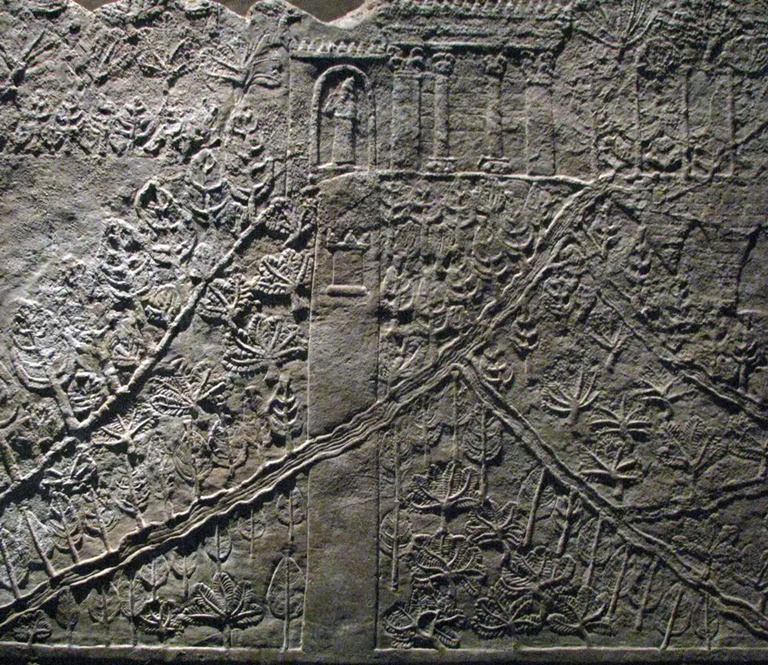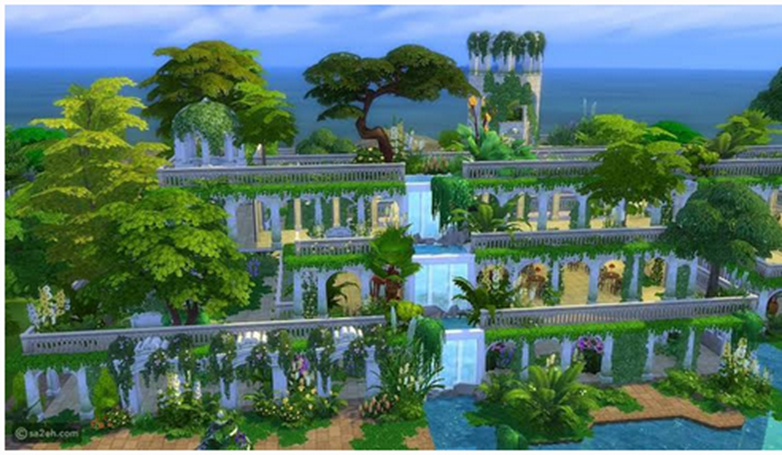!Researchers discover that the Hanging Gardens of Babylon were not in Babylon at all

While many believe that the Hanging Gardens of Babylon are nothing more than a legend circulated in ancient tongues and stories, modern research may prove conclusively that they actually existed, but not where they were thought to have existed before.
Imagine yourself traveling through a hot, barren desert in the Middle East, and then suddenly you notice a green landscape consisting of dense vegetation of trees, flowers, fruits, and fruits standing on top of columns and canopies at a height of up to 22 meters, extending before your eyes like a mirage rising from the hot sandy floor. Then, from this dense and diverse plant area, smells and fragrances of the East, West, North and South emerge from the various flowers and plants brought from different parts of the world. Then you continue your progress towards this desert paradise little by little until you reach what was known in ancient times as the “Hanging Gardens of Babylon”, which were built In the fourth century BC by King Nebuchadnezzar II.

The Hanging Gardens of Babylon as envisioned by an artist
Amitis, the wife of this Babylonian king, was born and raised in the country of Madai, which is located in the northwest of Iran today. She missed her mother country so much that she became sad. It is said that the king ordered the construction of these hanging gardens as a gift to his wife, who drowned in a sea of longing for her country. In order to remind her of him and relieve her of the feeling of longing.
The king built an irrigation system consisting of a network of water canals, and the water, which came from a river near the site, was raised high above the level of the gardens to later fall like a flowing waterfall. The engineering behind this design was what made historians and scientists classify the Hanging Gardens of Babylon among the “wonders of the world.” “The Seven.”

Ancient Greek historians wrote their description of what they thought the Hanging Gardens of Babylon looked like based on descriptive writings written by a monk who lived in the fourth century BC, known as Berosius of Chaldea. His writings were the oldest known description and documentation of these Hanging Gardens.
The Greek historian Diodorus Siculus, based on what he learned from the writings of Berosius, wrote in his description of the gardens: “The site of the gardens was curved like the side of a hill, and the various sections that made up the building rose above each other, and the soil was piled up on top of each layer of The layers of the structure...then trees of every type and type were planted, which, due to their sheer size and beauty, gave the viewer an indescribably beautiful feeling, and the water machines were raising water in large quantities from the river, even though it could not be seen from the outside.”

A painted picture of the Hanging Gardens of Babylon by Ferdinand Knapp in 1886.
The Greek descriptive writings about the Hanging Gardens of Babylon were based on the writings of an author who did not live in the era in which the gardens still existed, as he lived in a period generations after the destruction of the gardens.
Alexander the Great's army had also reached the Gardens of Babylon and some of his officers and soldiers reported that they were able to see them, but they had a great tendency to exaggerate and exaggerate facts and their reports cannot be considered reliable evidence.
The technology for watering hanging gardens at that time included a huge machine similar to the one invented by Archimedes, the use of which did not become widespread until centuries later. However, the lack of conclusive evidence, in addition to the lack of reports from people who directly witnessed the flowering period of gardens, led many scientists and researchers to believe that The gardens never existed, and they were only a legend circulating among people.

Then researcher Dr. Stephanie Daly came to the University of Oxford in 2013 and conducted in-depth research that gave a possible answer to this dilemma, as she hinted that ancient historians and researchers might have made a mistake about the location of the gardens and nothing more.
Daly was one of the most prominent experts in the civilizations of Mesopotamia, and she had discovered modern translations of ancient texts through which she believed that King Sennacherib was the one who built the Hanging Gardens and not Nebuchadnezzar II, as those gardens had been built in The Nineveh region is near the Iraqi city of Mosul today, and not in the city of Babylon as many thought.
This concept and modern discovery changes the location of the Gardens from the Babylonian Kingdom to the Assyrian Kingdom, and what increased the confusion and confusion that occurred in the location of the Gardens among historians and ancient researchers is that King (Sennacherib) had called the city (Nineveh) the name (New Babylon).

The Hanging Gardens of Nineveh, as shown in this ancient clay tablet. You, dear reader, can notice the water channel and columns in the upper section of the tablet.
Excavation work conducted near the city of Mosul supports researcher Daly's theory, as archaeologists succeeded in extracting evidence proving the existence of a huge machine that may have been used to transport water from the Euphrates River to the gardens for irrigation. They also found ancient writings stating that this machine It was used in that era to deliver water to the city.
In addition to the above, archaeologists found sculptures and inscriptions showing beautiful, green gardens that derived their irrigation water through large water channels. The relatively high area of Mosul, surrounded by plateaus, was more likely to receive water from the water channel compared to the flat area of Babylon.

Daly followed her theory by explaining that the Assyrians had invaded Babylon in the year 689 BC, and that was before the time of the construction of the Hanging Gardens of Babylon, and from this it is clear that ancient Greek historians made a mistake in locating the gardens between Assyrian Nineveh and Babylonian Babylon.
Hence, many efforts to uncover the mystery surrounding one of the seven wonders of the world were in vain, as it was based on the erroneous reports of these historians. As a result, much of the excavation work conducted in the twentieth century focused on the ancient city of Babylon and neglected the city of Nineveh. These mathematical errors in determining the location are what also made some researchers and scientists doubt the existence of these gardens in the first place.

While researchers and scientists explore the secrets of the city of Nineveh, who knows what compelling evidence they may find that further supports the existence of these vast gardens, as the site where excavations are currently taking place near the city of Mosul is located on a layered plateau, just as Greek historians described it. In their reports.
As for the appearance of these hanging gardens and how they looked, we have not yet received a direct, accurate writing or description from someone who lived in the period when they were still in existence, and until archaeologists find ancient texts describing what these gardens looked like, all that is What you can do, dear reader, is visit the closest botanical garden to you, wander among its various plants, and then at some point close your eyes and let your imagination wander on a time journey to 2,500 years in the past, the time of ancient kings and epic invaders.
Source: all that is interesting website

